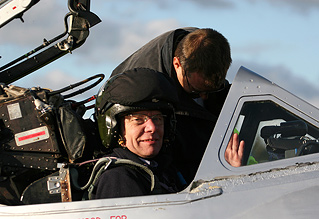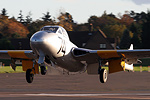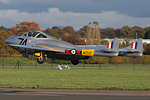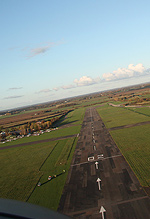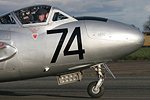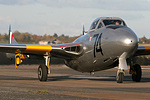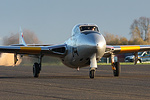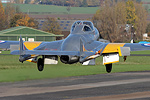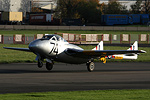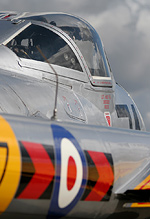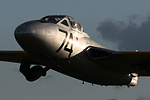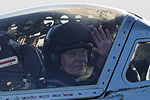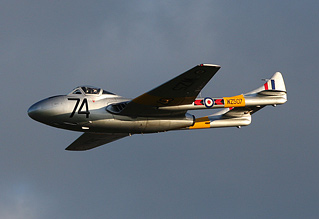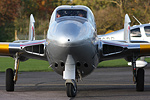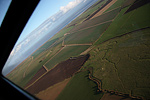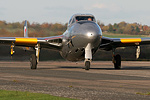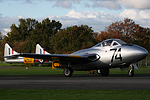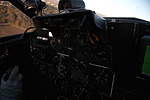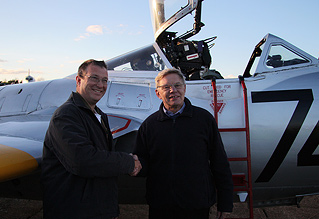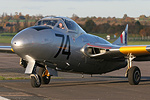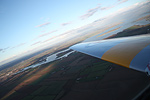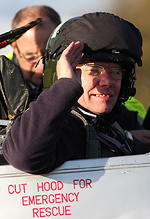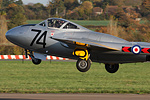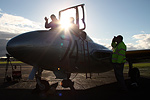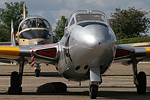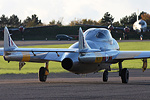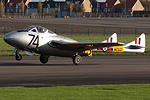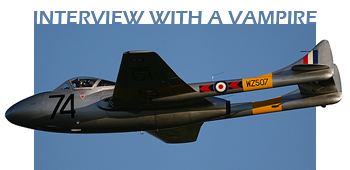
Flying The Vampire T.11
Sunday 7th November 2010
When I heard I'd been given an opportunity to fly in a Vampire T.11 I was speechless, but at the same time very excited at the prospect of flying in such a wonderful aeroplane, especially as I had never flown in any jet-powered aircraft before. Dates for the flight came and went with various reasons for the flight being postponed. These included a bout of swine flu, followed by snow, job schedules, annual servicing, Icelandic volcanic ash, bad weather and holidays until the date came when all parties were available. This was Sunday November 7th 2010. The flight was arranged for 2pm and the weather forecast was good.
recalls the flight of a lifetime for UK Airshow Review. Photos as credited.
The Vampire Preservation Group De Havilland Vampire T11 is based at North Weald airfield, Essex and we arrived there at about 12.30pm. We were just in time to see the Vampire depart on another flight.
The excitement by this time was quite intense. This was mixed with some apprehension, but at the same time I had a strong desire to be flying in that superb little aeroplane.
Having been to numerous airshows over the years, I have always wondered what the "G" forces, experienced by fighter pilots performing aerobatics was really like. Modern day pilots have "G" suits which counteract the effects on their bodies. This flight would give me some indication of this albeit much milder.
The chief pilot of the Vampire Preservation Group, Matt Hampton, an experienced pilot who normally flies Boeing 767's for a major UK airline, took me to one side to complete all the legal documentation prior to moving out to the Vampire. Refuelling was necessary before we embarked. This gave us a chance to get our cameras and take many shots of this fine vintage aircraft.
Then, the moment I had been waiting for. I was invited to climb aboard. The ladder to gain access to the cockpit was put in place and I climbed in. The cockpit area was smaller than I imagined, but I managed to get my near 14 stone frame into the right hand seat. Matt, or should I call him Captain Hampton, climbed in and proceeded to fasten me in. I did not realise that there were so many belts and buckles to fix.
Having belted himself in, we put on our flying helmets. Matt then started to brief me about what he proposed to do and asked me if there was anything I would like to do on the flight. He went on to explain what I would need to do in the event of a very unlikely, but possible catastrophic situation arising. His words went something like this: "Firstly, pull on this chrome loop on your left hand side. I will jettison the canopy and roll the aircraft upside down. Next release the seat straps by rotating the lever on the buckle - at this point you should fall clear of the aircraft. You then pull on another loop behind the original one, which is the rip-cord for the parachute" Simple, I thought.
He then reduced the stress somewhat by telling me that the Vampire, because of its fairly expansive wing area, was capable of gliding for some distance and we should be able to find a field in which to land the plane if any conceivable emergency occurred.
So, the stage was set for the flight. Matt performed all the pre-flight checks, most of which I understood and proceeded to start the de Havilland Goblin engine, which packs 3,200lbs of thrust. Most of my entourage were busy with their cameras, taking pictures of the flames issuing from the jet engine, a perfectly normal function of this type of engine on start-up. Matt gradually wound up the engine and asked me if I was ok to which I gave the thumbs up and this superb vintage aircraft moved off and taxied to the end of the runway.
Waiting, at the side of the runway was a film crew who were making a DVD about the aircraft. Matt told me that we were to be filmed on take-off for the DVD the Vampire Preservation Group are producing about the aircraft and we were to make an aborted take-off to allow the film crew to move to a different position further down the runway to get an alternative view. Unfortunately my entourage had not been told of this, so when they saw the Vampire slowing down at the end of the aborted take-off, they naturally assumed there was a problem. Fortunately, they saw the film crew and realised what was happening. Meanwhile we were back at the end of the runway receiving clearance for take-off.
The engine speed increased and when full power was reached, Matt released the brakes. At this point I said to myself, "This is it. This is what I have been waiting for." The runway at North Weald was quite bumpy, but I felt quite calm as the nose came up and we climbed gracefully into the air. Matt initially climbed to about 1,200 feet, to remain below Stansted's airspace, whilst turning on a heading taking us towards the Thames estuary.
Matt, very considerately, avoided flying directly over towns and villages so that local residents would not be disturbed by the noise of the Goblin engine. Although there were fairly good patches of blue sky, there was a large, black cloud ahead of us, which we flew under and the plane received a good soaking from the resultant torrential rain. When we were through it, Matt asked me if I would like to take the stick, to which I gave an emphatic thumbs-up. I had control of the stick for about 5 minutes and proceeded to weave the plane around villages, before Matt retook the stick.
He then asked me how I felt about aerobatics. Again it was thumbs-up from me, so he said we would do a wing-over and a roll. My grip upon my camera tightened as we climbed, comparatively steeply, before doing a roll, a manoeuvre which takes about 3 seconds in a Vampire. The sensation from this was quite pleasant, as it was performed very smoothly. We followed this up by a wing-over; both very enjoyable manoeuvres.
With the Thames estuary in view ahead, Matt banked the plane to head back to the airfield. He then said he would reduce the power to idle and this would prove it's gliding capabilities to me. Sure enough, the plane glided perfectly before he powered-up the engine and gave me another go with the stick. The large black cloud loomed up again in front of us and he asked me to steer the plane around the edge of it. Our airspeed at this time was about 250 knots (approx 290mph). He reduced the speed to about 150 knots to demonstrate how much lighter the controls were at the lower speed. Having successfully steered around the cloud, Matt reclaimed the stick to take us back to North Weald. As we approached the runway, I could see my entourage standing on a hillock, where they would get a good view as we flew past, before breaking and completing a circuit of the airfield and coming in for a perfect landing.
We taxied back to the aircraft park close to the hangars following a fire truck, the occupants of which were filming the DVD. After we came to a stop and the aircraft was shut down, we released the seat belts, removed our helmets and climbed out. After a photo of Matt and myself standing alongside the plane, I hitched a lift back to the other side of the airfield in the fire truck, where my family were waiting to greet me.
The flight was a truly wonderful, once in a lifetime experience. I wish to express my sincere thanks to Matt Hampton for his patience and kindness and all the members of the Vampire Preservation Group who all voluntarily give their time to keep this fantastic little jet fighter in the air.
To learn more about the group and to help support the ongoing operation of the aircraft, please visit the Vampire Preservation Group's official website.
You can also keep up to date with all that's happening right here on UKAR in Chief Pilot Matt Hampton's VPG Blog.
